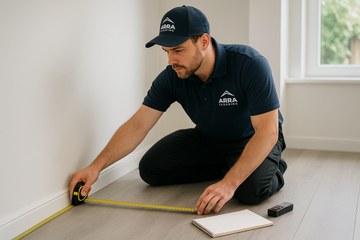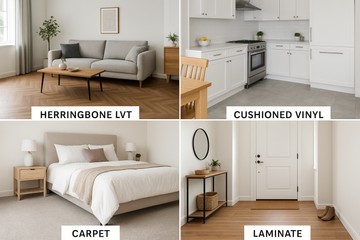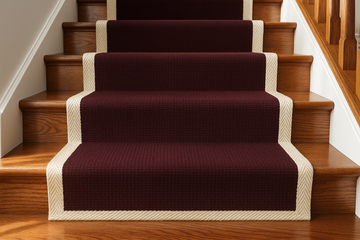How to Measure Rooms for Flooring: A Professional Guide with Photos

Why Accurate Room Measurements Matter
Measuring rooms correctly is the foundation of any successful flooring project. Accurate measurements ensure you order the right amount of material, minimize waste, and avoid costly delays. At Arra Flooring, we've guided hundreds of customers through the measurement process for carpet, LVT, laminate, and vinyl installations.
Whether you're planning a single-room renovation or a whole-house flooring project, understanding how to measure rooms properly will save you time, money, and frustration.
Essential Tools for Room Measurement
Before you begin measuring your rooms, gather these professional-grade tools:
- Steel measuring tape (25-30 feet minimum)
- Laser measure (for large rooms and accuracy)
- Graph paper for sketching room layouts
- Pencil and notepad for recording measurements
- Calculator for square footage calculations
- Helper (recommended for holding tape measure)
- Smartphone camera for reference photos

Step-by-Step Room Measurement Guide
1. Create a Room Sketch
Start by drawing a rough sketch of each room on graph paper:
- Include all doorways and openings
- Mark built-in furniture and permanent fixtures
- Note alcoves, bay windows, and irregular shapes
- Indicate the direction of room entry
- Label each room clearly
2. Measure Room Length and Width
For rectangular rooms, measure the longest walls first:
- Measure wall to wall at the longest points
- Take measurements at multiple points - rooms aren't always perfectly square
- Record the longest measurement for each dimension
- Measure in feet and inches or convert to decimal feet

3. Handle Irregular Shapes
For L-shaped or complex rooms, break them into rectangles:
- Divide complex shapes into simple rectangles
- Measure each section separately
- Calculate the square footage for each section
- Add sections together for the total room area
- Subtract areas where flooring won't be installed
4. Account for Doorways and Transitions
Measure doorway openings and transition areas:
- Measure doorway width for transition strips
- Note door swing direction for clearance
- Consider threshold height differences
- Plan for expansion gaps around the perimeter
5. Measure Closets and Alcoves
Don't forget these often-overlooked areas:
- Walk-in closets - measure as separate rooms
- Reach-in closets - measure depth and width
- Bay windows - measure each angled section
- Under stairs - measure accessible areas
Calculating Square Footage

Basic Square Footage Formula
For rectangular rooms, the calculation is straightforward:
Length × Width = Square Footage
Example: 12 feet × 15 feet = 180 square feet
Complex Room Calculations
Example: L-Shaped Living Room
- Section A: 12' × 15' = 180 sq ft
- Section B: 8' × 10' = 80 sq ft
- Total room: 180 + 80 = 260 sq ft
- Add 10% waste: 260 + 26 = 286 sq ft
- Final order: 290 square feet
Waste Factor Guidelines
Always add extra material for waste and future repairs:
- Straight installations: Add 5-10%
- Diagonal installations: Add 10-15%
- Patterned materials: Add 10-20%
- Complex layouts: Add 15-20%
- Future repairs: Order extra for storage
Flooring-Specific Measurement Tips
🏠 Carpet Measurements
- Consider carpet roll width (4m or 5m)
- Plan seam placement carefully
- Account for pile direction
- Add extra for pattern matching
🔲 LVT & Laminate
- Consider plank direction
- Plan for expansion gaps
- Account for underlayment
- Consider transition strips
📐 Vinyl & Sheet Goods
- Minimize seams where possible
- Consider roll width limitations
- Plan for template-making
- Account for pattern repeat
Professional Tips from Arra Flooring
📏 Measure Twice, Order Once
Double-check all measurements before placing your order. Small errors can lead to significant material shortages.
📱 Use Technology
Laser measures and smartphone apps can improve accuracy, especially for large rooms.
🗂️ Keep Detailed Records
Maintain organized notes with room names, dates, and measurements for future reference.
🏗️ Consider Installation Method
Different installation patterns require different amounts of material and waste factors.
Common Measurement Mistakes to Avoid
- ❌ Forgetting closets and alcoves - These areas add significant square footage
- ❌ Not accounting for waste - Always add 10-20% extra material
- ❌ Measuring over furniture - Move furniture for accurate wall-to-wall measurements
- ❌ Ignoring room irregularities - Few rooms are perfectly rectangular
- ❌ Mixing measurement units - Stick to feet and inches or decimal feet consistently
- ❌ Not planning for transitions - Consider doorways and level changes
- ❌ Assuming all rooms are square - Always measure multiple points
When to Call Professional Measurers
While room measurement is manageable for most homeowners, consider professional help for:
- Commercial spaces - Large areas require professional accuracy
- Complex layouts - Multiple levels, curves, or unusual shapes
- Expensive materials - High-end flooring warrants professional measurement
- Insurance claims - Professional documentation may be required
- Time constraints - Professional measurers work quickly and accurately
- Multiple rooms - Whole-house projects benefit from professional coordination

Ready for Professional Flooring Installation?
Get Expert Measurement & Installation
At Arra Flooring, our experienced team provides professional measurement services and expert installation for all flooring types. We serve customers throughout Ireland with precision, quality, and craftsmanship you can trust.
📞 Contact us today for a free consultation and accurate measurement
Let our professionals ensure your flooring project is measured perfectly and installed flawlessly.
Room Measurement Checklist
Before You Start:
- ☐ Gather all necessary tools
- ☐ Clear rooms of furniture where possible
- ☐ Prepare graph paper and pencil
- ☐ Plan your measurement route
During Measurement:
- ☐ Sketch each room layout
- ☐ Measure length and width at multiple points
- ☐ Record all measurements clearly
- ☐ Note any obstacles or irregularities
- ☐ Measure closets and alcoves
- ☐ Take photos for reference
After Measurement:
- ☐ Calculate the square footage for each room
- ☐ Add the appropriate waste factor
- ☐ Double-check all calculations
- ☐ Organize measurements by room
- ☐ Keep records for future reference









